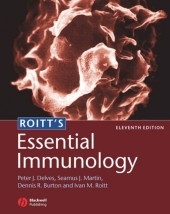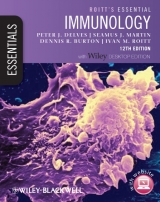
Roitt's Essential Immunology
Blackwell Publishing Ltd (Verlag)
978-1-4051-3603-7 (ISBN)
- Titel ist leider vergriffen;
keine Neuauflage - Artikel merken
Professor Ivan Roitt, University College London Dr Peter Delves, University College London Professor Dennis Burton, Scripps Research Institute Professor Seamus Martin, Trinity College, Dublin
1 Innate immunity. External barriers against infection. Phagocytic cells kill microorganisms. Complement facilitates phagocytosis. Complement can mediate an acute inflammatory reaction. Humoral mechanisms provide a second defensive strategy. Extracellular killing. 2 Specific acquired immunity. Antibody-the specific adaptor. Cellular basis of antibody production. Acquired memory. Acquired immunity has antigen specificity. Vaccination depends on acquired memory. Cell-mediated immunity protects against intracellular organisms. Immunopathology. 3 Antibodies. The division of labor. Five classes of immunoglobulin. The IgG molecule. The structure and function of the immunoglobulin classes. Genetics of antibody diversity and function. 4 Membrane receptors for antigen. The B-cell surface receptor for antigen (BCR). The T-cell surface receptor for antigen (TCR). The generation of diversity for antigen recognition. NK receptors. The major histocompatibility complex (MHC). 5 The primary interaction with antigen. What antibodies see. Identifying B-cell epitopes on a protein. Thermodynamics of antibody-antigen interactions. Specificity and cross-reactivity of antibodies. What the T-cell sees. Processing of intracellular antigen for presentation by Class I MHC. Processing of antigen for Class II MHC presentation follows a different pathway. Cross-presentation for activation of naive CD8+ T-cells. The nature of the 'groovy' peptide. The alphabeta T-cell receptor forms a ternary complex with MHC and antigenic peptide. T-cells with a different outlook. Superantigens stimulate whole families of lymphocyte receptors. The recognition of different forms of antigen by B- and T-cells is advantageous to. the host. 6 Immunological methods and applications. Making antibodies to order. Purification of antigens and antibodies by affinity chromatography. Modulation of biological activity by antibodies. Immunodetection of antigen in cells and tissues. Detection and quantitation of antigen by antibody. Epitope mapping. Estimation of antibody. Detection of immune complex formation. Isolation of leukocyte subpopulations. Gene expression analysis. Assessment of functional activity. Genetic engineering of cells. 7 The anatomy of the immune response. The need for organized lymphoid tissue. Lymphocytes traffic between lymphoid tissues. Lymph nodes. Spleen. The skin immune system. Mucosal immunity. Bone marrow can be a major site of antibody synthesis. The enjoyment of privileged sites. The handling of antigen. 8 Lymphocyte activation. Clustering of membrane receptors leads to their activation. T-lymphocytes and antigen-presenting cells interact through several pairs of. accessory molecules. The activation of T-cells requires two signals. Protein tyrosine phosphorylation is an early event in T-cell signaling. Downstream events following TCR signaling. B-cells respond to three different types of antigen. The nature of B-cell activation. 9 The production of effectors. Cytokines act as intercellular messengers. Different T-cell subsets can make different cytokine patterns. Activated T-cells proliferate in response to cytokines. T-cell effectors in cell-mediated immunity. Proliferation and maturation of B-cell responses are mediated by cytokines. What is going on in the germinal center?. The synthesis of antibody. Immunoglobulin class switching occurs in individual B-cells. Factors affecting antibody affinity in the immune response. Memory cells. 10 Control mechanisms. Antigens can interfere with each other. Complement and antibody also play a role. Activation-induced cell death. T-cell regulation. Idiotype networks. The influence of genetic factors. Regulatory immunoneuroendocrine networks. Effects of diet, exercise, trauma and age on immunity. 11 Ontogeny and phylogeny. Hematopoietic stem cells. The thymus provides the environment for T-cell differentiation. T-cell ontogeny. T-cell tolerance. B-cells differentiate in the fetal liver and then in bone marrow. B-1 and B-2 cells represent two distinct populations. Development of B-cell specificity. The induction of tolerance in B-lymphocytes. Natural killer (NK) cell ontogeny. The overall response in the neonate. The evolution of the immune response. The evolution of distinct B- and T-cell lineages was accompanied by the development. of separate sites for differentiation. Cellular recognition molecules exploit the immunoglobulin gene superfamily. 12 Adversarial strategies during infection. Inflammation revisited. Extracellular bacteria susceptible to killing by phagocytosis and complement. Bacteria which grow in an intracellular habitat. Immunity to viral infection. Immunity to fungi. Immunity to parasitic infections. 13 Vaccines. Passively acquired immunity. Vaccination. Killed organisms as vaccines. Live attenuated organisms have many advantages as vaccines. Subunit vaccines containing individual protective antigens. Epitope-specific vaccines may be needed. Current vaccines. Vaccines under development. Vaccines against parasitic diseases have proved particularly difficult to develop. Vaccines for protection against bioterrorism. Immunization against cancer. Other applications for vaccines. Adjuvants. . 14 Immunodeficiency. Deficiencies of innate immune mechanisms. Primary B-cell deficiency. Primary T-cell deficiency. Combined immunodeficiency. Recognition of immunodeficiencies. Treatment of primary immunodeficiencies. Secondary immunodeficiency. Acquired immunodeficiency syndrome (AIDS). 15 Hypersensitivity. Anaphylactic hypersensitivity (Type I). Antibody-dependent cytotoxic hypersensitivity (Type II). Immune complex-mediated hypersensitivity (Type III). Cell-mediated (delayed-type) hypersensitivity (Type IV). Stimulatory hypersensitivity (Type V). 'Innate' hypersensitivity reactions. 16 Transplantation. Genetic control of transplantation antigens. Some other consequences of MHC incompatibility. Mechanisms of graft rejection. The prevention of graft rejection. Is xenografting a practical proposition?. Stem cell therapy. Clinical experience in grafting. The fetus is a potential allograft. 17 Tumor immunology. Cellular transformation and immune surveillance. Tumor antigens. Spontaneous immune responses to tumors. Tumor escape mechanisms. Unregulated development gives rise to lymphoproliferative disorders. Approaches to cancer immunotherapy. Immunodiagnosis of solid tumors. 18 Autoimmune diseases. The scope of autoimmune diseases. Nature and nurture. Autoreactivity comes naturally. Is autoimmunity driven by antigen?
| Erscheint lt. Verlag | 18.7.2006 |
|---|---|
| Reihe/Serie | Essentials |
| Zusatzinfo | 173 |
| Verlagsort | Oxford |
| Sprache | englisch |
| Maße | 219 x 275 mm |
| Gewicht | 1546 g |
| Einbandart | Paperback |
| Themenwelt | Studium ► Querschnittsbereiche ► Infektiologie / Immunologie |
| ISBN-10 | 1-4051-3603-0 / 1405136030 |
| ISBN-13 | 978-1-4051-3603-7 / 9781405136037 |
| Zustand | Neuware |
| Haben Sie eine Frage zum Produkt? |
aus dem Bereich



